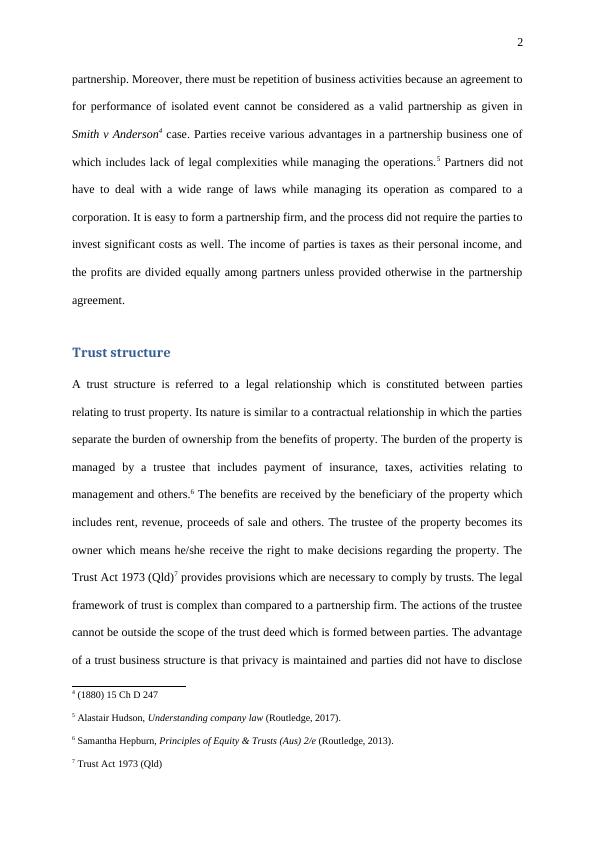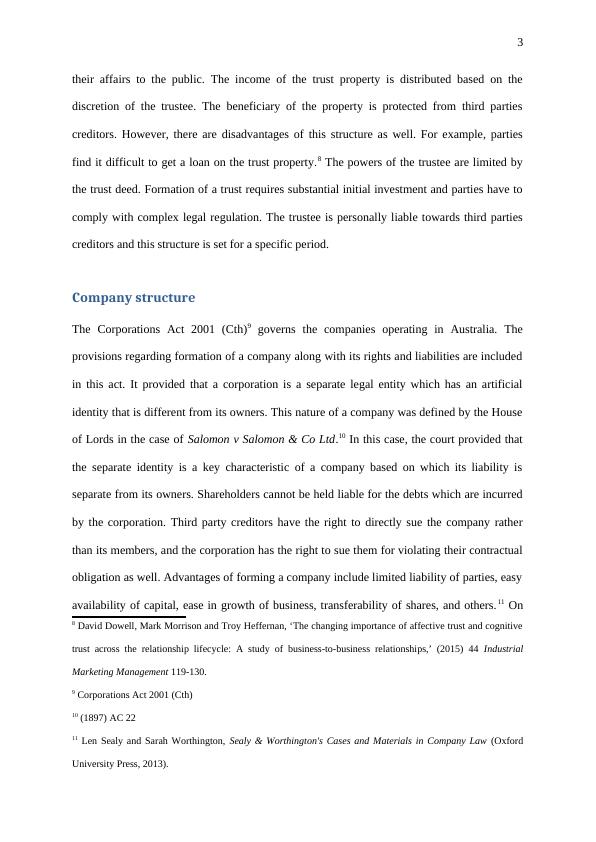Comparison of Business Structures: Partnership, Trust and Company
Added on 2023-05-29
14 Pages3742 Words481 Views
0
Companies and Business Structure
Companies and Business Structure

1
Part 1
A business structure is referred to a category of organisations which are legally recognised in
a given jurisdiction and characterised by the legal definition of particular category. Selection
of a suitable business structure is necessary to ensure that the corporation is able to avoid
complexity in the legal compliance and it is able to avoid legal penalties. Parties can choose
between different business structures each of which has separate characteristics which
provide advantages and disadvantages of corporations. Following are difference between
nature and characteristics between partnerships, trust and corporate structure along with
evaluation of their advantages and disadvantages.
Partnership structure
In case two or more parties wanted to start a business structure, then they can select the
partnership business structure. It is governed under the Partnership Act 1891 (Qld).1 Under
section 5 of this Act, the definition of partnership is given. It is referred as a legal relationship
which is constituted between two or more parties who agreed to run the operations of their
business in common in order to generate profit.2 The partners in a partnership firm cannot
exceed over 20 members. The key characteristics of a partnership are that it did not have a
separate entity like a corporation based on which the partners have unlimited liability in the
business. They are liable for the debts of the business, and they are liable for the actions of
other partners as well. In Joyce v Morrissey3 case, the court provided that the relationship
between parties is a key criterion which must be fulfilled in order to constitute a valid
1 Partnership Act 1891 (Qld)
2 Legislation, Partnership Act 1891 (2018) < https://www.legislation.qld.gov.au/view/html/inforce/current/act-
1891-007 >.
3 (1998) TLR 707
Part 1
A business structure is referred to a category of organisations which are legally recognised in
a given jurisdiction and characterised by the legal definition of particular category. Selection
of a suitable business structure is necessary to ensure that the corporation is able to avoid
complexity in the legal compliance and it is able to avoid legal penalties. Parties can choose
between different business structures each of which has separate characteristics which
provide advantages and disadvantages of corporations. Following are difference between
nature and characteristics between partnerships, trust and corporate structure along with
evaluation of their advantages and disadvantages.
Partnership structure
In case two or more parties wanted to start a business structure, then they can select the
partnership business structure. It is governed under the Partnership Act 1891 (Qld).1 Under
section 5 of this Act, the definition of partnership is given. It is referred as a legal relationship
which is constituted between two or more parties who agreed to run the operations of their
business in common in order to generate profit.2 The partners in a partnership firm cannot
exceed over 20 members. The key characteristics of a partnership are that it did not have a
separate entity like a corporation based on which the partners have unlimited liability in the
business. They are liable for the debts of the business, and they are liable for the actions of
other partners as well. In Joyce v Morrissey3 case, the court provided that the relationship
between parties is a key criterion which must be fulfilled in order to constitute a valid
1 Partnership Act 1891 (Qld)
2 Legislation, Partnership Act 1891 (2018) < https://www.legislation.qld.gov.au/view/html/inforce/current/act-
1891-007 >.
3 (1998) TLR 707

2
partnership. Moreover, there must be repetition of business activities because an agreement to
for performance of isolated event cannot be considered as a valid partnership as given in
Smith v Anderson4 case. Parties receive various advantages in a partnership business one of
which includes lack of legal complexities while managing the operations.5 Partners did not
have to deal with a wide range of laws while managing its operation as compared to a
corporation. It is easy to form a partnership firm, and the process did not require the parties to
invest significant costs as well. The income of parties is taxes as their personal income, and
the profits are divided equally among partners unless provided otherwise in the partnership
agreement.
Trust structure
A trust structure is referred to a legal relationship which is constituted between parties
relating to trust property. Its nature is similar to a contractual relationship in which the parties
separate the burden of ownership from the benefits of property. The burden of the property is
managed by a trustee that includes payment of insurance, taxes, activities relating to
management and others.6 The benefits are received by the beneficiary of the property which
includes rent, revenue, proceeds of sale and others. The trustee of the property becomes its
owner which means he/she receive the right to make decisions regarding the property. The
Trust Act 1973 (Qld)7 provides provisions which are necessary to comply by trusts. The legal
framework of trust is complex than compared to a partnership firm. The actions of the trustee
cannot be outside the scope of the trust deed which is formed between parties. The advantage
of a trust business structure is that privacy is maintained and parties did not have to disclose
4 (1880) 15 Ch D 247
5 Alastair Hudson, Understanding company law (Routledge, 2017).
6 Samantha Hepburn, Principles of Equity & Trusts (Aus) 2/e (Routledge, 2013).
7 Trust Act 1973 (Qld)
partnership. Moreover, there must be repetition of business activities because an agreement to
for performance of isolated event cannot be considered as a valid partnership as given in
Smith v Anderson4 case. Parties receive various advantages in a partnership business one of
which includes lack of legal complexities while managing the operations.5 Partners did not
have to deal with a wide range of laws while managing its operation as compared to a
corporation. It is easy to form a partnership firm, and the process did not require the parties to
invest significant costs as well. The income of parties is taxes as their personal income, and
the profits are divided equally among partners unless provided otherwise in the partnership
agreement.
Trust structure
A trust structure is referred to a legal relationship which is constituted between parties
relating to trust property. Its nature is similar to a contractual relationship in which the parties
separate the burden of ownership from the benefits of property. The burden of the property is
managed by a trustee that includes payment of insurance, taxes, activities relating to
management and others.6 The benefits are received by the beneficiary of the property which
includes rent, revenue, proceeds of sale and others. The trustee of the property becomes its
owner which means he/she receive the right to make decisions regarding the property. The
Trust Act 1973 (Qld)7 provides provisions which are necessary to comply by trusts. The legal
framework of trust is complex than compared to a partnership firm. The actions of the trustee
cannot be outside the scope of the trust deed which is formed between parties. The advantage
of a trust business structure is that privacy is maintained and parties did not have to disclose
4 (1880) 15 Ch D 247
5 Alastair Hudson, Understanding company law (Routledge, 2017).
6 Samantha Hepburn, Principles of Equity & Trusts (Aus) 2/e (Routledge, 2013).
7 Trust Act 1973 (Qld)

3
their affairs to the public. The income of the trust property is distributed based on the
discretion of the trustee. The beneficiary of the property is protected from third parties
creditors. However, there are disadvantages of this structure as well. For example, parties
find it difficult to get a loan on the trust property.8 The powers of the trustee are limited by
the trust deed. Formation of a trust requires substantial initial investment and parties have to
comply with complex legal regulation. The trustee is personally liable towards third parties
creditors and this structure is set for a specific period.
Company structure
The Corporations Act 2001 (Cth)9 governs the companies operating in Australia. The
provisions regarding formation of a company along with its rights and liabilities are included
in this act. It provided that a corporation is a separate legal entity which has an artificial
identity that is different from its owners. This nature of a company was defined by the House
of Lords in the case of Salomon v Salomon & Co Ltd.10 In this case, the court provided that
the separate identity is a key characteristic of a company based on which its liability is
separate from its owners. Shareholders cannot be held liable for the debts which are incurred
by the corporation. Third party creditors have the right to directly sue the company rather
than its members, and the corporation has the right to sue them for violating their contractual
obligation as well. Advantages of forming a company include limited liability of parties, easy
availability of capital, ease in growth of business, transferability of shares, and others.11 On
8 David Dowell, Mark Morrison and Troy Heffernan, ‘The changing importance of affective trust and cognitive
trust across the relationship lifecycle: A study of business-to-business relationships,’ (2015) 44 Industrial
Marketing Management 119-130.
9 Corporations Act 2001 (Cth)
10 (1897) AC 22
11 Len Sealy and Sarah Worthington, Sealy & Worthington's Cases and Materials in Company Law (Oxford
University Press, 2013).
their affairs to the public. The income of the trust property is distributed based on the
discretion of the trustee. The beneficiary of the property is protected from third parties
creditors. However, there are disadvantages of this structure as well. For example, parties
find it difficult to get a loan on the trust property.8 The powers of the trustee are limited by
the trust deed. Formation of a trust requires substantial initial investment and parties have to
comply with complex legal regulation. The trustee is personally liable towards third parties
creditors and this structure is set for a specific period.
Company structure
The Corporations Act 2001 (Cth)9 governs the companies operating in Australia. The
provisions regarding formation of a company along with its rights and liabilities are included
in this act. It provided that a corporation is a separate legal entity which has an artificial
identity that is different from its owners. This nature of a company was defined by the House
of Lords in the case of Salomon v Salomon & Co Ltd.10 In this case, the court provided that
the separate identity is a key characteristic of a company based on which its liability is
separate from its owners. Shareholders cannot be held liable for the debts which are incurred
by the corporation. Third party creditors have the right to directly sue the company rather
than its members, and the corporation has the right to sue them for violating their contractual
obligation as well. Advantages of forming a company include limited liability of parties, easy
availability of capital, ease in growth of business, transferability of shares, and others.11 On
8 David Dowell, Mark Morrison and Troy Heffernan, ‘The changing importance of affective trust and cognitive
trust across the relationship lifecycle: A study of business-to-business relationships,’ (2015) 44 Industrial
Marketing Management 119-130.
9 Corporations Act 2001 (Cth)
10 (1897) AC 22
11 Len Sealy and Sarah Worthington, Sealy & Worthington's Cases and Materials in Company Law (Oxford
University Press, 2013).

End of preview
Want to access all the pages? Upload your documents or become a member.
Related Documents
Corporations and Business Structure PDFlg...
|10
|3423
|70
Business Structurelg...
|11
|3534
|416
Choosing the Right Business Structure in Australialg...
|11
|3157
|282
Corporation Law in Australia: Business Structures and Legal Obligationslg...
|5
|1066
|70
Commercial and Corporations Law: Business Structures and Directors' Dutieslg...
|12
|3208
|60
Corporation and Business Structurelg...
|12
|3444
|476